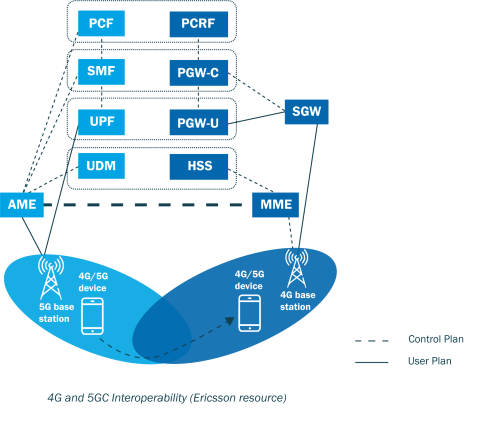In France, the start of the 5G SA deployment was announced this year. The migration from an EPC (4G) core network to a 5GC core network represents significant investments. Operators must define a strategy that ensures the continuity of existing 4G services, which poses many technical challenges.
The migration to a 5GC core network is essential in order to unlock the full potential of 5G and to realize and develop the different business models being experimented with in the B2B market.
In France, three operators have already launched: Orange and SFR prefer to use Finnish equipment manufacturer Nokia, while Bouygues will rely on Ericsson.
How to Choose Your Operational Strategy for Migration to 5GC
To deploy a 5GC network, the operator has several options:
- Choose a 5GC solution from one of the vendors in its network or from a new vendor.
- Deploy a new 5GC solution directly, or upgrade its EPC platform to 5GC.
- Build a 5GC solution with native cloud technology, or start with a virtualized solution and migrate progressively to a native, private, public or hybrid cloud.
The 5GC core network is more complex than the EPC core network (4G) since it integrates new network functions (NF). The integration and interoperability of these different functions (NF) becomes more complex, especially in the case of multi-vendor networks.
Scenario 1: EPC Core Network Upgrade with Same Vendor
The majority of operators that have migrated to 5G have upgraded their EPC (4G) network to an NSA architecture. More limited in terms of automation and orchestration capabilities than a 5GC architecture, the 5G NSA architecture is not fully compatible with the requirements of a native cloud network.
Therefore, operators have virtualized the main EPC nodes (EPC to vEPC) and then gradually introduced new 5G SA functions in parallel. This strategy allows a fast Time To Market (TTM) for new services and optimization of CAPEX/OPEX since the reuse or transfer of 4G licenses is possible. It requires less time for operational teams to learn about new products and environments. Most importantly, it reduces the risk of interoperability issues between existing EPC (4G) functions and new 5GC functions, a prerequisite in order to avoid degrading the customer experience.
Prior to the complete decommissioning of the EPC network, operators will need to migrate their entire customer base to the new platform, batch by batch.
Scenario 2: Migration of the EPC Network to Another 5GC Solution Provider
Changing the supplier is a long and risky process: the operator must launch a call for proposals and eventually go through a test phase of the different technical solutions proposed to validate their performance and compliance with the main standards (3GPP).
Operators will have to make choices and compromises to take into account the requirements of a 5GC network and the constraints of the existing EPC network. Three cases may arise.
- The operator chooses to replace Vendor A with Vendor B by implementing a solution on a new 5GC native cloud platform. This choice can be relevant. The risk is to remain dependent on Vendor A during the time it takes for the teams to become proficient on the new platform.
- The operator virtualizes its EPC network, then migrates to a native cloud network on a small or medium scale. Teams can gradually upgrade their skills without impacting production platforms and services. This option allows for easy migration of subscribers to the new vEPC platform.
- The operator starts by virtualizing its EPC network on VMs, then introduces a 5GC solution and migrates to the native cloud. This is the least risky option. It optimizes the TTM.
Interoperability Between EPC (4G) and New 5GC Functions Is Strategic
Operators have invested heavily in the EPC core network to provide more capacity to their customers during the health crisis. They want to capitalize on these investments before turning to 5GC, but the 5GC service offering is also their strategic priority.
Smooth interoperability between the EPC network and the 5GC network is necessary to avoid degrading the customer experience on existing services when the customer migrates from one network to the other.
The 3GPP standard has defined several interfaces between network functions (NF). However, the N26 interface between the MFA function (5GC) and the MME function (EPC) plays a crucial role in signaling and control. It must be maintained to guarantee a successful switching of the subscriber between the two systems. In particular, this interface enables the management of voice-related services (voLTE) and is used for the transfer of the subscriber's history between the two systems.

The customer database is another key element for the successful interoperability of the two systems.
Inevitable Changes in the Ecosystem
The operator will have other adaptations to make:
- Adapt the internal operational organization to take advantage of the benefits of a native cloud architecture.
- Choose between deploying a single-vendor or multi-vendor 5GC solution. The integration of a single-vendor 5GC solution will be simpler and faster, but with a risk of dependency. A multi-vendor solution will require much more integration time.
- Migrate their RAN access to a 5G RAN access that enables end-to-end 5G services to best use the capabilities of a 5GC network.
5GC: A Suitable Architecture for Cloud-Native Environments
Cloud-native 5GC is a next-generation, scalable and highly available architecture for 5G networks. It enables service providers to run 5G core network functions as cloud-native applications, leveraging the benefits of virtualization, automation and orchestration. This architecture offers faster innovation cycles, improved network agility and lower operational costs than traditional 5G core deployments.
In summary, operators have 7 challenges to face to deploy their 5GC network:
- Interoperability: the operation of a 5GC core network with a wide range of different services and environments (EPC, NR, etc.) can induce important risks of degradation of existing services during its implementation.
- Complexity: By integrating new functions, the 5GC network is more complex than the EPC (4G), which also complicates its design, deployment and maintenance.
- Security: The 5GC network creates new challenges in securing IOT terminals and equipment for data protection.
- Network slicing: The management and maintenance of virtual networks (slices) with different levels of security and sensitivity of data and applications will represent a new challenge for operators.
- Virtualization and software solutions: Managing virtualization and software solutions for 5GC networks requires new expertise and skills.
- Cost: 5GC requires significant investment in new infrastructure and technology in an already competitive environment for operators.
- Regulations: In some countries, regulations will require 5G networks to store and process data within the country or limit the ability of foreign companies to participate in 5G network deployments. These regulations may increase the cost and complexity of network operations.
Read more : The 5GC core network, the cornerstone of 5G Standalone




